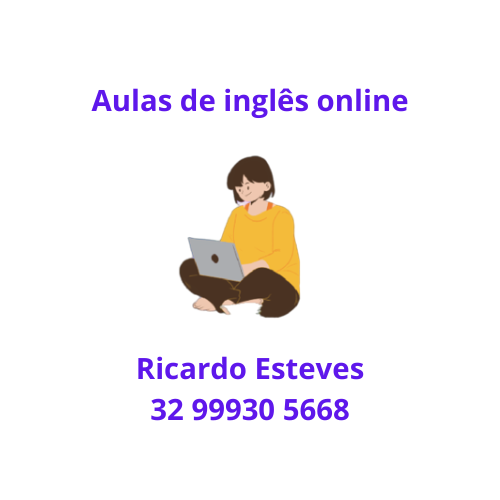Hoje você aprenderá 50 palavras em inglês relacionadas ao trabalho. Para você que está empregado ou está em busca de um emprego, segue um diálogo entre o professor e o aluno. O professor explica ao aluno várias palavras e frases são criadas para esclarecer ainda mais o vocabulário. Bons estudos!
Aprenda 50 palavras em inglês relacionadas ao trabalho
today we’re going to learn 50 words related to work. I’ll say the word, and you can explain what it’s used for and make a sentence with it in English. Ready?
Student: Yes, I’m ready!
Teacher: Great! The first word is “office.”
Student: An office is a place where people work, usually with desks and computers. Example sentence: “She works in a big office downtown.”
Teacher: Good! Next word: “desk.”
Student: A desk is a piece of furniture where you can sit and work, usually with a computer, papers, and other office supplies. Example sentence: “He keeps his desk very organized.”
Teacher: Excellent! Now, “chair.”
Student: A chair is something you sit on while working at your desk. Example sentence: “My office chair is very comfortable.”
Teacher: Perfect! The next word is “computer.”
Student: A computer is an electronic device used for various tasks like typing, researching, and communicating. Example sentence: “She uses her computer to complete her reports.”
Teacher: Good job! How about “keyboard”?
Student: A keyboard is a device with keys that you press to type letters and numbers into a computer. Example sentence: “The keyboard on my laptop is very responsive.”
Teacher: Well done! Next, “mouse.”
Student: A mouse is a small device used to move the cursor on a computer screen and click on items. Example sentence: “I prefer using a wireless mouse.”
Teacher: Excellent! The next word is “monitor.”
Student: A monitor is a screen that displays the output from a computer. Example sentence: “The new monitor has a very high resolution.”
Teacher: Great! Now, “printer.”
Student: A printer is a machine that prints documents and images from a computer onto paper. Example sentence: “We need to buy more ink for the printer.”
Teacher: Very good! Next word: “notebook.”
Student: A notebook is a book of blank or lined paper for writing notes. Example sentence: “I always carry a notebook to meetings.”
Teacher: Excellent! And the tenth word is “pen.”
Student: A pen is an instrument for writing or drawing with ink. Example sentence: “She signed the contract with a blue pen.”
Teacher: Wonderful! You’re doing great.
The next word is “pencil.”
Student: A pencil is a tool for writing or drawing, usually made of wood with a graphite core that can be erased. Example sentence: “He sketched the design with a pencil.”
Teacher: Good! Now, “paper.”
Student: Paper is a thin material that you can write or print on. Example sentence: “Please print the document on A4 paper.”
Teacher: Excellent! Next word: “stapler.”
Student: A stapler is a device used to fasten sheets of paper together with staples. Example sentence: “She used the stapler to bind the reports.”
Teacher: Well done! How about “folder”?
Student: A folder is a holder for organizing and protecting documents. Example sentence: “He kept all his important papers in a blue folder.”
Teacher: Very good! Now, “telephone.”
Student: A telephone is a device used for voice communication over a distance. Example sentence: “She answered the telephone promptly.”
Teacher: Great! Next word: “calculator.”
Student: A calculator is an electronic device used for mathematical calculations. Example sentence: “I used a calculator to check the budget numbers.”
Teacher: Excellent! How about “calendar”?
Student: A calendar is a system for organizing days, often used to schedule appointments. Example sentence: “She marked the meeting date on her calendar.”
Teacher: Very good! The next word is “clipboard.”
Student: A clipboard is a flat board with a clip at the top to hold papers in place for writing. Example sentence: “The coach carried a clipboard during practice.”
Teacher: Good! Now, “paperclip.”
Student: A paperclip is a small piece of bent wire used to hold sheets of paper together. Example sentence: “He used a paperclip to keep the documents together.”
Teacher: Excellent! And the twentieth word is “highlighter.”
Student: A highlighter is a pen with transparent, fluorescent ink used to mark text. Example sentence: “She used a yellow highlighter to mark important points in the report.”
Teacher: Fantastic! You’re doing a great job. Let’s move on to the next set of words.
Student: Ready when you are!
Teacher: The next word is “whiteboard.”
Student: A whiteboard is a smooth, white surface where you can write and draw using special markers. Example sentence: “The teacher wrote the lesson plan on the whiteboard.”
Teacher: Good! Now, “marker.”
Student: A marker is a pen with a thick tip used for writing on whiteboards or other surfaces. Example sentence: “He used a black marker to write the headings.”
Teacher: Excellent! Next word: “envelope.”
Student: An envelope is a flat paper container used to hold letters or documents. Example sentence: “She sealed the letter in an envelope and mailed it.”
Teacher: Very good! How about “scissors”?
Student: Scissors are a tool with two blades used for cutting paper or other materials. Example sentence: “He used scissors to cut the paper into smaller pieces.”
Teacher: Great! Next word: “tape.”
Student: Tape is a sticky strip used to attach or repair items. Example sentence: “She used tape to wrap the present.”
Teacher: Excellent! The next word is “notepad.”
Student: A notepad is a small book of blank or lined pages for writing notes. Example sentence: “He jotted down the ideas in his notepad.”
Teacher: Very good! Now, “staples.”
Student: Staples are small metal pieces used in a stapler to fasten papers together. Example sentence: “We ran out of staples for the stapler.”
Teacher: Good job! The next word is “rubber band.”
Student: A rubber band is a stretchy loop of rubber used to hold items together. Example sentence: “She used a rubber band to keep the documents in a bundle.”
Teacher: Excellent! Next word: “file cabinet.”
Student: A file cabinet is a piece of furniture with drawers for storing documents. Example sentence: “He filed the paperwork in the file cabinet.”
Teacher: Very good! And the thirtieth word is “post-it note.”
Student: A post-it note is a small piece of paper with a re-adherable strip of glue on its back for temporarily attaching notes to documents or surfaces. Example sentence: “She left a post-it note on his desk reminding him of the meeting.”
Teacher: Wonderful! You’re doing great.
Student: Thank you!
Teacher: The next word is “binder.”
Student: A binder is a cover for holding loose sheets of paper, often with rings that open and close. Example sentence: “He organized his notes in a three-ring binder.”
Teacher: Good! Now, “clipboard.”
Student: We already discussed “clipboard.” Should we move on to the next word?
Teacher: Oh, right! Sorry about that. Let’s go with “glue.”
Student: Glue is a sticky substance used for joining things together. Example sentence: “She used glue to stick the photo in her scrapbook.”
Teacher: Excellent! Next word: “hole punch.”
Student: A hole punch is a tool used to make holes in paper for placing in a binder. Example sentence: “He used a hole punch to prepare the documents for the meeting.”
Teacher: Very good! How about “file”?
Student: A file is a folder or box for holding loose papers that are typically arranged in a particular order for easy reference. Example sentence: “She kept all her receipts in a file.”
Teacher: Great! Next word: “index card.”
Student: An index card is a small card used for recording and organizing information. Example sentence: “He prepared index cards with key points for his presentation.”
Teacher: Excellent! The next word is “push pin.”
Student: A push pin is a short pin with a round head used for attaching papers to a board. Example sentence: “She used push pins to hang pictures on the bulletin board.”
Teacher: Very good! Now, “rubber stamp.”
Student: A rubber stamp is a device with a raised design used for imprinting a mark or symbol on paper. Example sentence: “He used a rubber stamp to mark the documents as ‘approved.'”
Teacher: Good job! The next word is “tape dispenser.”
Student: A tape dispenser is a device that holds a roll of tape and has a cutting edge for easy use. Example sentence: “She pulled the tape from the tape dispenser to seal the package.”
Teacher: Excellent! Next word: “paper shredder.”
Student: A paper shredder is a machine used to cut paper into small pieces for disposal. Example sentence: “He used a paper shredder to destroy confidential documents.”
Teacher: Very good! And the fortieth word is “whiteout.”
Student: Whiteout is a liquid or tape used to cover mistakes on paper. Example sentence: “She used whiteout to correct the error on the form.”
Teacher: Wonderful! You’re doing fantastic. Let’s finish with the last set of words.
Student: I’m ready!
Teacher: The next word is “laminator.”
Student: A laminator is a machine that applies a protective plastic layer to documents. Example sentence: “He used the laminator to protect the presentation materials.”
Teacher: Good! Now, “letterhead.”
Student: Letterhead is the heading at the top of a sheet of letter paper, usually consisting of a name and an address. Example sentence: “She printed the letter on company letterhead.”
Teacher: Excellent! Next word: “memo.”
Student: A memo is a written message, especially in business. Example sentence: “He sent a memo to the staff about the new policy.”
Teacher: Very good! How about “spreadsheet”?
Student: A spreadsheet is a digital document in which data is arranged in rows and columns, often used for calculations. Example sentence: “She tracked the budget using a spreadsheet.”
Teacher: Great! Next word: “agenda.”
Student: An agenda is a list of items to be discussed at a meeting. Example sentence: “The manager distributed the agenda before the meeting.”
Teacher: Excellent! The next word is “briefcase.”
Student: A briefcase is a flat, rectangular container for carrying papers and documents. Example sentence: “He carried his documents in a leather briefcase.”
Teacher: Very good! Now, “conference call.”
Student: A conference call is a telephone call in which multiple people participate. Example sentence: “They scheduled a conference call to discuss the project.”
Teacher: Good job! The next word is “deadline.”
Student: A deadline is the latest time by which something must be completed. Example sentence: “She worked hard to meet the project deadline.”
Teacher: Excellent! Next word: “meeting room.”
Student: A meeting room is a room designated for holding meetings. Example sentence: “They reserved the meeting room for the afternoon.”
Teacher: Very good! And the fiftieth word is “projector.”
Student: A projector is a device that projects an image onto a surface, like a screen. Example sentence: “He used a projector to display his presentation.”
Teacher: Fantastic! You’ve done a great job with all 50 words. Keep practicing, and you’ll master them in no time.
Student: Thank you! This was very helpful. I’ll review these words and try to use them in my daily conversations.








